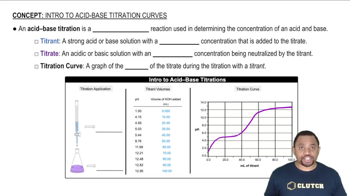A 25.0-mL sample of 0.125 M pyridine is titrated with 0.100 M HCl. Calculate the pH at each volume of added acid: one-half equivalence.
Ch.17 - Aqueous Ionic Equilibrium
Chapter 17, Problem 74h
A 25.0-mL sample of 0.125 M pyridine is titrated with 0.100 M HCl. Calculate the pH at each volume of added acid: 0 mL, 10 mL, 20 mL, equivalence point, one-half equivalence point, 40 mL, 50 mL. Sketch the titration curve.
 Verified step by step guidance
Verified step by step guidance1
1. First, let's understand the concept of titration. Titration is a process in which a solution of known concentration (the titrant) is used to determine the concentration of an unknown solution (the analyte). In this case, pyridine is the analyte and HCl is the titrant. Pyridine is a weak base and HCl is a strong acid. During the titration, the acid will react with the base to form a salt and water, changing the pH of the solution.
2. To calculate the pH at each volume of added acid, we need to consider the reaction between pyridine and HCl. The reaction is: C5H5N + HCl -> C5H5NH+ + Cl-. The initial concentration of pyridine is 0.125 M and the concentration of HCl is 0.100 M. The volume of pyridine is 25.0 mL.
3. For 0 mL of HCl, no reaction has occurred, so the pH is determined by the initial concentration of pyridine. We can use the formula for the pH of a weak base: pH = 14 - pOH, where pOH = -log[OH-]. The [OH-] can be found using the Kb of pyridine and the initial concentration.
4. For 10 mL, 20 mL, 40 mL, and 50 mL of HCl, we need to calculate the moles of HCl added and subtract that from the initial moles of pyridine to find the moles of pyridine left. Then, we can calculate the new concentration of pyridine and use the same formula as in step 3 to find the pH.
5. At the equivalence point, all the pyridine has reacted with the HCl. The pH at the equivalence point is determined by the hydrolysis of the pyridine salt formed. We can use the formula for the pH of a salt solution: pH = 7 + 0.5pKa - 0.5log[C], where C is the concentration of the salt. The pKa can be found from the Kb of pyridine.
6. At the half-equivalence point, half of the pyridine has reacted with the HCl. The pH at the half-equivalence point is equal to the pKa of the pyridine.
7. To sketch the titration curve, plot the volume of HCl added on the x-axis and the pH on the y-axis. The curve will start at the initial pH of the pyridine solution, rise gradually as HCl is added, then rise sharply near the equivalence point, and finally level off as excess HCl is added.

Verified Solution
Video duration:
13mWas this helpful?
Key Concepts
Here are the essential concepts you must grasp in order to answer the question correctly.
Titration
Titration is a quantitative analytical technique used to determine the concentration of a solute in a solution. It involves the gradual addition of a titrant (in this case, HCl) to a solution containing the analyte (pyridine) until the reaction reaches its equivalence point, where stoichiometrically equivalent amounts of acid and base have reacted. Understanding the titration process is essential for calculating pH at various points during the titration.
Recommended video:
Guided course

Acid-Base Titration
pH and pKa
pH is a measure of the acidity or basicity of a solution, defined as the negative logarithm of the hydrogen ion concentration. In the context of weak bases like pyridine, the pKa of the conjugate acid (pyridinium ion) is crucial for calculating pH at different stages of the titration. The Henderson-Hasselbalch equation can be used to find pH at the half-equivalence point, where the concentrations of the weak base and its conjugate acid are equal.
Recommended video:
Guided course

The pH Scale
Titration Curve
A titration curve is a graphical representation of pH changes as a function of the volume of titrant added during a titration. It typically features a gradual increase in pH, followed by a steep rise near the equivalence point, and then levels off. Analyzing the shape of the titration curve helps identify key points such as the equivalence point and half-equivalence point, which are critical for understanding the acid-base behavior of the solution.
Recommended video:
Guided course

Acid-Base Titration Curves
Related Practice
Textbook Question
453
views
Textbook Question
A 25.0-mL sample of 0.125 M pyridine is titrated with 0.100 M HCl. Calculate the pH at each volume of added acid: 40 mL.
1123
views
Textbook Question
A 25.0-mL sample of 0.125 M pyridine is titrated with 0.100 M HCl. Calculate the pH at each volume of added acid: 50 mL.
332
views
Textbook Question
Consider the titration curves (labeled a and b) for two weak acids, both titrated with 0.100 M NaOH.
(i) Which acid solution is more concentrated?
1495
views
Textbook Question
Consider the titration curves (labeled a and b) for two weak acids, both titrated with 0.100 M NaOH.
(ii) Which acid has the larger Ka?
895
views
Textbook Question
Consider the titration curves (labeled a and b) for two weak bases, both titrated with 0.100 M HCl. (a)
(b)
(ii) Which base has the larger Kb?
1104
views
